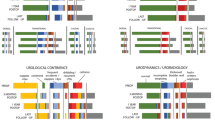Heading
Abstract
Objectives. Our objectives were to examine the assumption that the natural history of congenital lumbosacral lipomas in children presenting early and those presenting late is the same, and to determine whether there are factors that might predict the post-operative outcome of surgery among the presenting features of children with lumbosacral lipomas.
Methods. The authors present a clinical series of 50 consecutive cases of congenital lumbosacral lipoma that had been treated surgically. All patients underwent both pre- and post-operative urological assessment and pre-operative imaging with MRI. The case notes, urology assessments and MRI films were studied to provide data on the clinical presentation, follow-up history and urological outcome of the children, as well as on the anatomical features of their lipomas.
Results. Analysis of the data revealed a predominance in girls and a bimodal distribution of age at presentation with peaks at 0–2 and 7–8 years. Skin stigmata were more frequent in children below 6 years of age than in older children (P=0.035). The MRI scans demonstrated that the conus lay within the sacral canal more often in girls than boys (P=0.025). Severe bladder dysfunction was significantly more frequent in those presenting at =3 years of age (P=0.017) and there were more normal outcomes in patients operated upon before the age of 3 than in those operated upon at or after this age (P<0.0001). Eight patients who had been operated upon had severe urological problems at the time of their last assessment (median age of 8 years and 2 months). They were predominantly girls with major pre-operative urological dysfunction.
Conclusions. Formal pre-operative urological assessment proved to be the strongest determinant of final urological outcome. Other predictors of poor urological outcome were large lipoma size and sacral position for the lipoma. This series demonstrates how early and late presenting children may represent different patient groups, follow different natural histories and may therefore not be reliable for comparison purposes. Future studies of prophylactic untethering need to follow cohorts beyond the age of deterioration found in untreated cases (8 years) and must report the salient MRI features that we suggest are predictive of poor outcome.
Similar content being viewed by others
Author information
Authors and Affiliations
Additional information
Electronic Publication
Rights and permissions
About this article
Cite this article
Dorward, N.L., Scatliff, J.H. & Hayward, R.D. Congenital lumbosacral lipomas: pitfalls in analysing the results of prophylactic surgery. Childs Nerv Syst 18, 326–332 (2002). https://doi.org/10.1007/s00381-002-0624-x
Received:
Revised:
Published:
Issue Date:
DOI: https://doi.org/10.1007/s00381-002-0624-x




